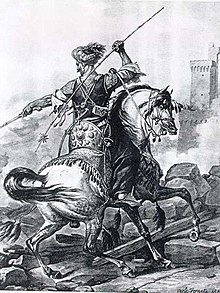Mamluk

Mamluks (or Mameluks) (the Arabic word usually translates as "owned", singular: مملوك plural: مماليك) comprised slave soldiers used by the Muslim Caliphs and the Ottoman Empire, and who on more than one occasion seized power for themselves.
The first Mamluks worked for Abbasid caliphs in 9th-century Baghdad. The Abbasids recruited them from enslaved non-Muslim families captured in areas including modern Turkey, Eastern Europe, and the Caucasus. Using non-Muslims as soldiers helped partially overcome Islamic prohibitions on Muslims fighting each other. The rulers also desired troops with no link to the established power structure. The local warriors were often more loyal to their tribal sheiks, their families or nobles other than the sultan or caliph. If some commander conspired against the ruler, it was often not possible to deal with him without causing unrest among the nobility. The slave-troops were strangers of the lowest possible status who could not conspire against the ruler and who could easily be punished if they caused trouble.
After being converted to Islam, they were trained as cavalry soldiers, while technically after training they were no longer slaves they were still obliged to serve the Sultan. They were kept by the Sultan as an outsider force, under their direct command, to use in the event of local tribal frictions. Many Mamluks rose to high positions throughout the empire, including commanderships. Status remained non-hereditary at first and children were strictly prevented from following their fathers. The intensive and rigorous training given to each new recruit helped ensure a great deal of continuity in Mamluk practices.
Mamluks in Egypt

Two Mamluk dynasties ruled Egypt: the Bahri (بحري meaning 'of the sea', referring to their center in al-Manial Island in the Nile, and consisting of Turks and Mongols) and Burji (برجي meaning 'of the tower', referring to their center in the Cairo Citadel, and consisting of Circassians and Georgians). The Bahri led the way in breaking the rule of non-hereditary positions by establishing a dynasty ruled by a few families. Through this period and until the 19th century, the Mamluk dynasties continued to increase their numbers by purchasing more slave soldiers.
The Mamluk dynasties of Egypt were instrumental in defeating the invading Mongol invaders under Qutuz, and in eliminating the last remnants of the Crusaders from Egypt and Syria under Baibars, Qalawun, and Khalil.
The influence of the Mamluk dynasties on Syria and Egypt is still evident today in the architecture of mosques, schools, and libraries, as well as bridges, water fountains and other public works.
In 1517 Egypt was taken over by the Ottoman Empire. The Mamluks remained in charge of the state, which retained much autonomy from Constantinople.
In 1768 Sultan Ali Bey Al-Kabir declared independence from the Ottomans but the Mamluks crushed the movement and retained their position after his defeat. By this time new slave recruits were introduced from Georgia in the Caucasus. Napoleon defeated Mamluk troops when he attacked Egypt in 1798 and drove them to Upper Egypt. By this time Mamluks had added only muskets to their typical cavalry charge tactics. When Napoleon left Egypt, his officers failed to contain the Mamluk rebellion. When French troops departed 1801, the Mamluks fought against both the Ottoman Empire and the British Empire.
In 1806 Mohammad Ali Pasha became the governor of Egypt. In 1811 he invited a number of Mamluk leaders (accounts differ from 64 to 700) to his palace in Cairo and ambushed them in the street after the reception. Reputedly only one leader survived the Citadel Massacre. During the following weeks, Mohammed Pasha's troops killed thousands of Mamluks all over the country. Only a small group managed to flee to Sudan effectively ending the era of Egyptian Mamluk rulers.
Mamluks in France
Napoleon formed his own Mamluk corps in the early years of the 19th century, the last known Mamluk force. Even his Imperial Guard had Mamluk soldiers during the Belgian campaign, including one of his personal servants. After the Battle of Austerlitz (2 December 1805) they gained their own regimental standard. Napoleon's famous bodyguard Roustan was also a Mamluk from Egypt. One of the pictures by Francisco de Goya shows a charge of Mamluks against the Madrilene in May 2, 1808.
Mamluks in Baghdad
In the Ottoman Empire, Mamluks of Baghdad proclaimed their independence in the 18th century and remained autonomous until the Ottoman reconquest in 1832.
Mamluks in India
In 1211, the Mamluk commander of the Muslim forces in India, Qutbuddin Aibak, proclaimed himself Sultan, becoming, in effect, the first independent Sultan-e-Hind. This Mamluk dynasty lasted until 1290. See Delhi Sultanate for more information.
Other slave soldiers
Other Islamic states used slave soldiers: note the janissaries of the Ottoman Empire and the saqaliba of Andalusi taifas, especially in Denia.
Related terms
Mameluco is a Portuguese word used to identify people of mixed European and Native American descent in South America. In the seventeenth and eighteenth centuries, Mameluco referred to organized bands of Portuguese slave-hunters, also known as bandeirantes, who roamed the vast interior of South America from the Atlantic to the slopes of the Andes, and from the Paraguay to the Orinoco raiding the Guarani-inhabited areas for slaves. Catholic Encyclopedia: Mameluco
